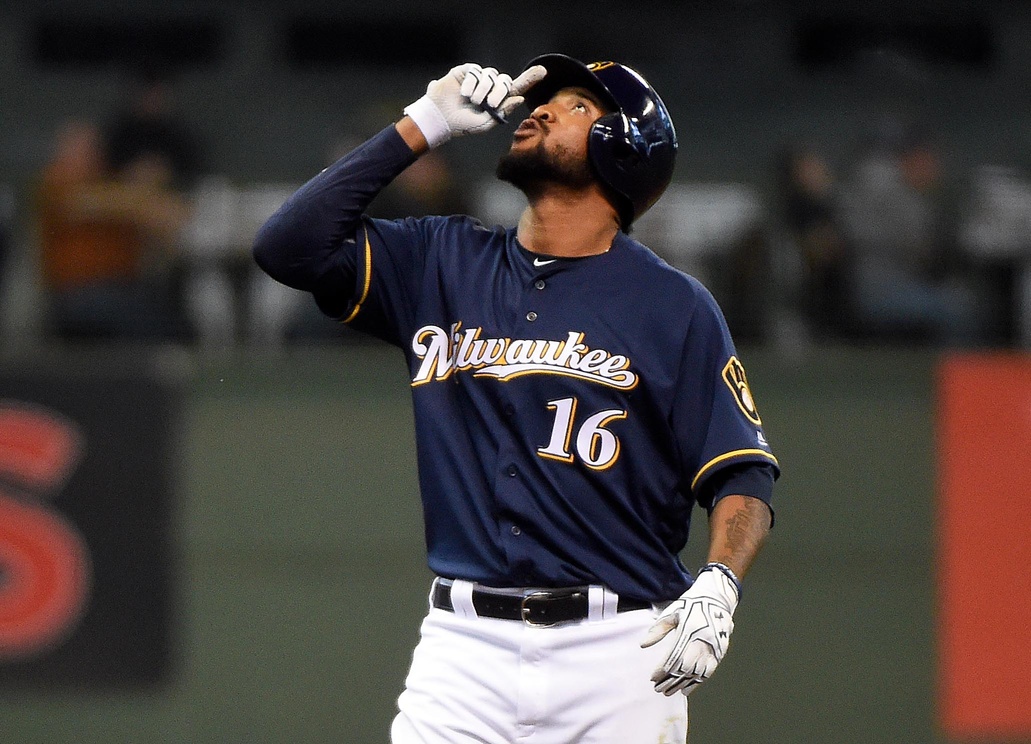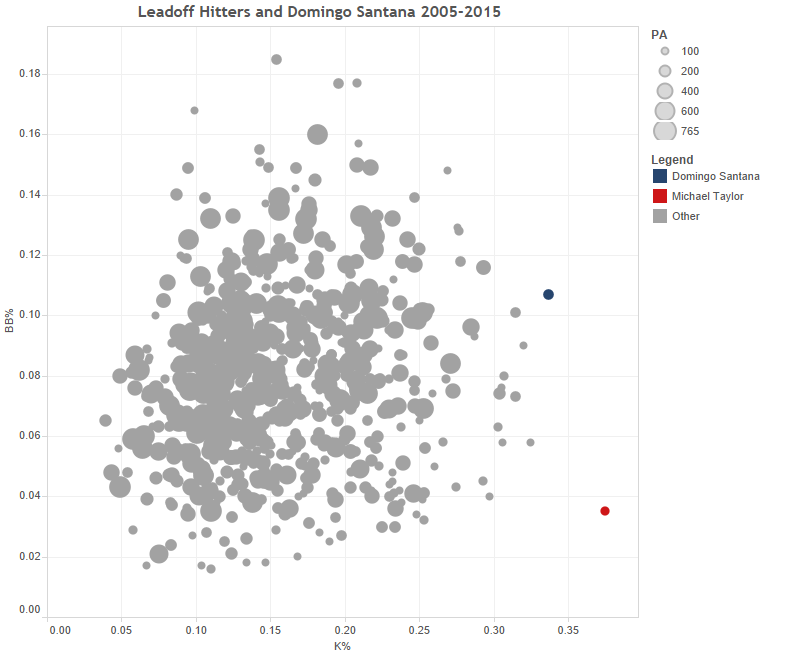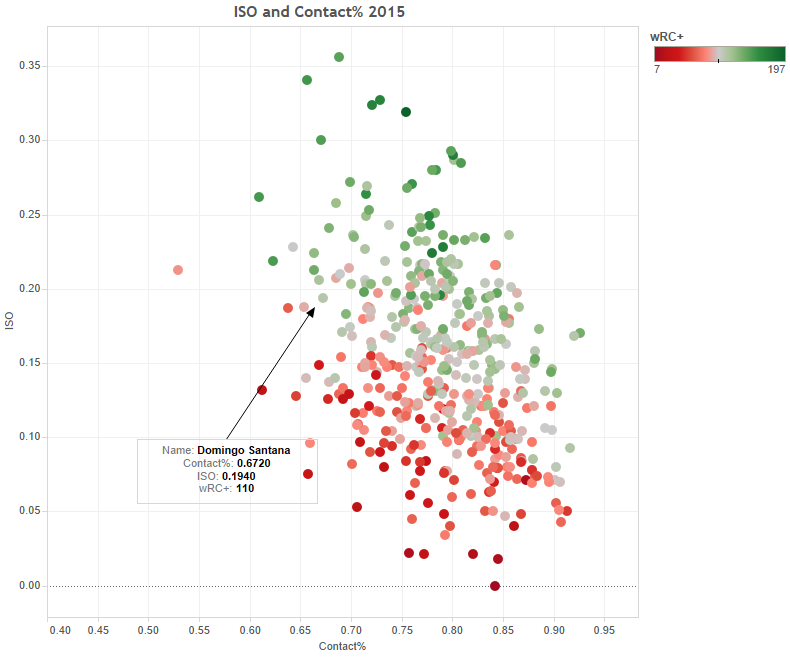We’re seven games into the season and I guess Domingo Santana is the Brewers leadoff hitter.
On the Brewers opening day recap, I mentioned this as a trend to watch. The Brewers were also playing against the Giants and Madison Bumgarner, therefore, Derek Harvey of Brew Crew Ball and I theorized that this might be the lineup versus left-handed pitchers. The reason being, Santana has typically been a much more prolific hitter versus left-handed pitchers, as opposed to right-handed pitchers. Hence, when the Brewers face a right-handed starter, Santana would be dropped in the lineup for someone who has typically had more success with righties and who better fits the profile of a leadoff hitter.
It’s not opening day anymore and Domingo Santana has led off every game. The Brewers have also faced five right-handed starting pitchers. Therefore, it seems as though Craig Counsel will have Santana in the leadoff position for the foreseeable future.
The reason Santana is a weird choice as leadoff is not because he’s a bad baseball player, or because he’s a bad hitter. Those two outcomes have yet to be determined. The reason Santana is such a weird fit for the specific lineup spot is because of his hitting profile.
Typically, we think of leadoff hitters as short, quick players who are good base stealers. They put the ball in play at an above average clip as to avoid strikeouts and get on base at a decent rate.
What’s odd about Santana is that apart from getting on base at an above-average clip, he doesn’t fit any of those predetermined stereotypes. In fact, it’s especially odd to see a player who strikes out so much as a leadoff hitter. (Santana wasn’t the Brewers leadoff hitter last season, but since we only have one year of Santana’s major league performance to go off of, I lumped him in with the leadoff hitters. Min 100 PA).
Santana’s base on ball’s profile isn’t that anomalous as compared to other leadoff hitters, but his strikeout profile definitely is. Since 2005, the only leadoff hitter who has had a bigger strikeout percentage than Santana’s 2015 season was Michael Taylor’s 2015 season.
The interesting part of all this is that strikeout and walk rates stabilize quickly. Strikeouts stabilize at 60 plate appearances and walks stabilize at 120 plate appearances. Therefore, it’s not unreasonable to think that Santana won’t deviate too much from this profile this upcoming season. Santana has also had a strikeout rate that hovers around 30 percent all throughout his minor league career.
While that wouldn’t be an unreasonable assumption, Santana’s strikeout rate this season is down from his 2015 or minor league rate. In 2016, he’s got a 22.6 strikeout percentage, which isn’t great but is still down from his norm. Now, it’s very early in the season, and these numbers might drop off, but the Brewers could have worked with Santana during the offseason. It’s possible that either the Brewers told Santana to change his hitting approach, to cut down on his strikeouts, or Santana is making adjustments on his own. Leading off comes with many preordain stereotypes and Santana might be trying to accommodate to those. These are simply theories, however, and are extremely unlikely. It’s a lot more likely that these are merely stats that are products of small sample sizes.
Leadoff hitters also have the stereotype of making a lot of contact and being threats on the base paths. Santana is neither of those things. Throughout his minor league career, he’s never been a base stealing threat. The oddest part, though, is his lack of ability to make contact. On average, major league players contact percentage is at 80 percent. In 187 plate appearances last year, Santana’s contact percentage was at 67.2 percent. That’s well below average, for all major league hitters, let alone leadoff hitters.
We also don’t have this sort of information for his minor league career, therefore, it’s hard to know whether this is a fluke or not, but at this point this should definitely be something to keep an eye on.
In 2015, only 18 players had a worse contact percentage than Santana. Most players who are in this profile, are Brewers old friend Khris Davis, Orioles’ Chris Davis, Kyle Schwarber, Kris Bryant, Giancarlo Stanton, which sounds like good company, but there’s always a flip side. There’s also Mike Zunino, Nick Franklin, Alex Avila, David Ross, Joc Pederson, Joey Butler and more. Basically, in order for these players to be successful, they need to hit for power. If they don’t then it’s highly probable that they won’t become a very good hitter.
None of these players are also leadoff hitters. Most of them are in the middle or at the back end of a lineup.
These players also depend heavily on the home run ball and hard contact. Just take a look at Chris Davis, who’s had a contact percentage of 68 percent for his career. When he hits home runs, and when he’s able to have a good BABIP then he’s an above average player, but in 2014, he “only” hit 26 home runs and his BABIP fell from .336 to .242 causing him to be a below average hitter. Basically, it doesn’t take a lot for these hitters to become below average. Santana’s BABIP was at .330 last years, and showed above average power, but as you can see in the graph, he’s in the gray area. If one of these stats drop, then he’ll probably end up being a below average hitter in 2016.
Thus far, in 2015, Santana’s contact percentage is at 76.2 percent, which is much higher than last year. Essentially early on, Santana looks, statistically, like a different hitter, but as the old adage goes, it’s still very early. We should still keep an eye on this and see if this trend continues but it’s unreasonable to assign any meaning to these numbers just yet.


